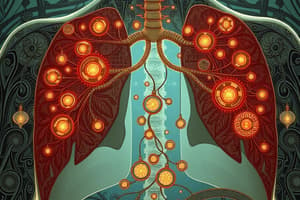Podcast
Questions and Answers
Which method do earthworms use for gas exchange?
Which method do earthworms use for gas exchange?
- Diffusion across gills
- Tracheal tubes for air transport
- Lungs for gas exchange
- Diffusion across their cuticle (correct)
Which group of animals primarily uses gills for respiration?
Which group of animals primarily uses gills for respiration?
- Birds
- Reptiles
- Aquatic arthropods (correct)
- Mammals
What structure do amphibians like frogs use for gas exchange?
What structure do amphibians like frogs use for gas exchange?
- Lungs only
- Tracheal tubes only
- Moist skin and lungs (correct)
- Gills only
What gas exchange mechanism is utilized by lower invertebrates?
What gas exchange mechanism is utilized by lower invertebrates?
Which of the following organisms does NOT rely on lungs for respiration?
Which of the following organisms does NOT rely on lungs for respiration?
What is the primary function of the epiglottis in the human respiratory system?
What is the primary function of the epiglottis in the human respiratory system?
Which structure serves as the main passageway for air before it reaches the lungs?
Which structure serves as the main passageway for air before it reaches the lungs?
What is the role of pleural fluid in the respiratory system?
What is the role of pleural fluid in the respiratory system?
At what anatomical location does the trachea divide into primary bronchi?
At what anatomical location does the trachea divide into primary bronchi?
How are the walls of the bronchi and trachea structurally supported?
How are the walls of the bronchi and trachea structurally supported?
Flashcards
Respiratory exchange in invertebrates
Respiratory exchange in invertebrates
Lower invertebrates exchange gases through diffusion across their entire body surface.
Earthworm respiration
Earthworm respiration
Earthworms use their moist cuticle for gas exchange.
Insect respiration
Insect respiration
Insects rely on a network of tracheal tubes for gas transport.
Aquatic arthropod/mollusc respiration
Aquatic arthropod/mollusc respiration
Signup and view all the flashcards
Vertebrate lung respiration
Vertebrate lung respiration
Signup and view all the flashcards
What are the nasal chambers?
What are the nasal chambers?
Signup and view all the flashcards
What is the pharynx?
What is the pharynx?
Signup and view all the flashcards
What is the larynx?
What is the larynx?
Signup and view all the flashcards
What is the trachea?
What is the trachea?
Signup and view all the flashcards
What are alveoli?
What are alveoli?
Signup and view all the flashcards
Study Notes
Respiratory Mechanisms in Animals
- Animals use various mechanisms to exchange gases, adapting to their environment and complexity
- Organisms like sponges, coelenterates, flatworms, etc., exchange O2 and CO2 through simple diffusion throughout their bodies.
- Earthworms use their moist cuticle, and insects possess a network of tubes (tracheal tubes) to transport air.
- Aquatic arthropods and molluscs utilize specialized vascularized structures called gills.
- Terrestrial animals (reptiles, birds, and mammals) employ vascularized bags (lungs) for gas exchange.
- Amphibians can breathe through their moist skin.
- Mechanisms vary in complexity based on habitat and levels of organization
- Mammals have a complex respiratory system.
Studying That Suits You
Use AI to generate personalized quizzes and flashcards to suit your learning preferences.




